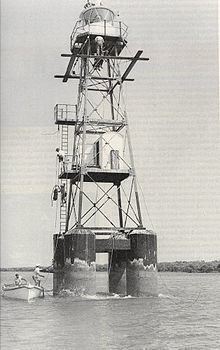Year first constructed 1910s (first) Height 11 m | Year first lit n/a (current) Focal height 12 m | |
 | ||
Location East Vernon IslandNorthern TerritoryAustralia Foundation four concrete piles and platform Construction metal skeletal tower (first)fiberglass tower (current) Tower shape square pyramidal skeletal tower with balcony and lantern (first)cylindrical tower and no lantern (current) Similar Emery Point Light, Cape Hotham Light, Alice Springs Reptile C, Territory Wildlife Park, Alice Springs Desert Pa | ||
East Vernon Light is an active lighthouse located on the water's edge at the south side of East Vernon Island, an island off the shore of the Northern Territory, Australia. The lighthouse guards the northeastern approach to Darwin.
The Vernon Islands were named on 21 May 1818 by Phillip Parker King at the King Expedition of 1817, honouring Edward Venables-Vernon-Harcourt.
History
The original lighthouse was constructed by the Commonwealth Lighthouse Service during the "Golden Age of Australian Lighthouses", between 1913 and 1920. It was a square skeletal tower with a lantern and a gallery, about 70 feet (21 m) high. The current red lighthouse was built on the same piles.
The light characteristic shown is a flash every five seconds, with a different color depending on the direction: white on 250°-042° and -094°, red on -088° and green on -105°. The light is obscured elsewhere (Fl.W.R.G. 5s). The red and green lights are visible for 8 nautical miles (15 km; 9.2 mi) while the white light is visible for 11 nautical miles (20 km; 13 mi).
The site is accessible by boat and the tower is closed to the public. The light is operated by the Australian Maritime Safety Authority.
